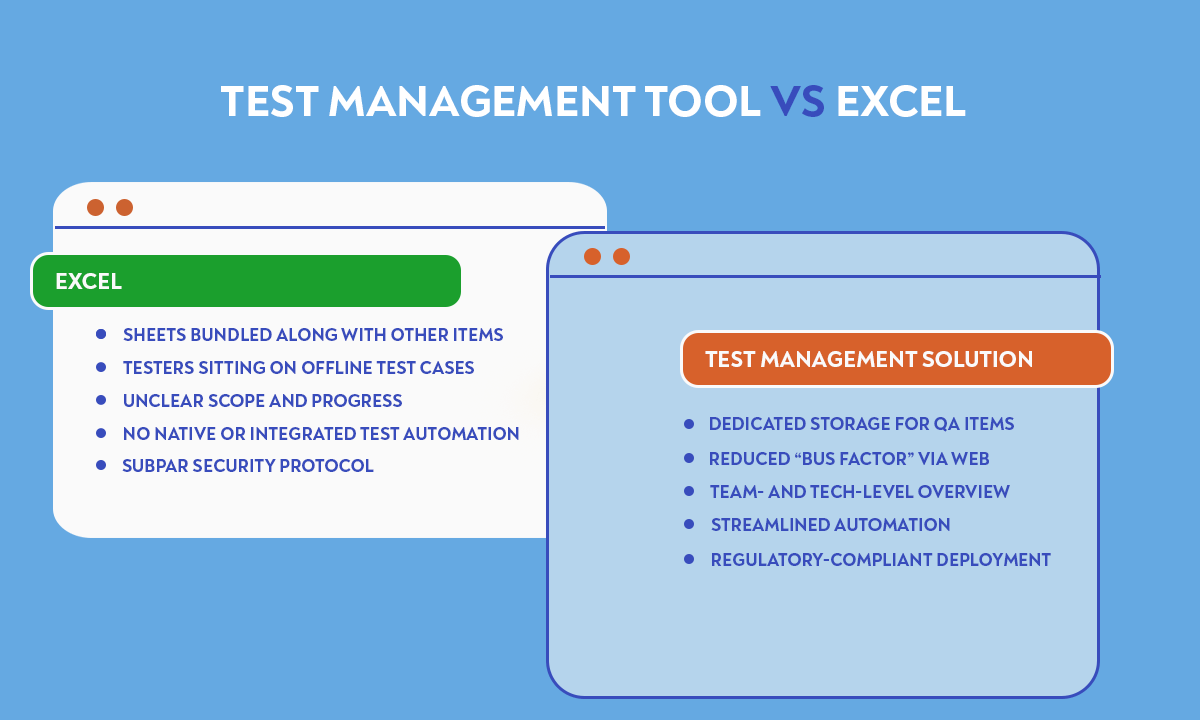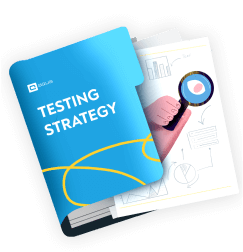Is Excel a test management tool?
You can use Excel as a basic tool for test management, but it falls short compared to dedicated test management tools like aqua cloud. While Excel allows you to create and organise test cases and track execution status, it lacks advanced features crucial for efficient testing. These include:
- Comprehensive collaboration capabilities
- Traceability between requirements and test cases
- Automation for test execution
- Integration with other QA & software development tools
- QA-specific reporting and dashboard functionalities
- Hassle-free, regulatory-compliant version control and history tracking
- Adequate security and access controls
Dedicated test management tools are purpose-built to address these limitations and provide a more effective and streamlined approach to managing the testing process.
Key differences between test management app vs Excel
The key difference between using Excel vs specialised tools lies in the philosophy, but it has very practical consequences. Business-wise, perhaps the biggest impact is whether you really know when to stop testing.
Test management with Excel is trying to shoehorn a (pretty advanced) spreadsheet editor into a QA tool. Test management solutions were designed as a QA tool and thus help you improve quality without the extra layer of clunkiness and limitations. The sensible choice is to manage your test cases, yet alone test scenarios with a dedicated solution.

Pros of using test management tool
Now that we outlined the key differences that can sway you to go with a test management tool or Excel, let’s further dive into the advantages of the modern route.
We’ve explored this topic extensively in our newest video. Make sure to check it out!
Security
Excel is no match for test management solutions when it comes to data security. They combine a great degree of protection and convenience. Most solutions bring modern authentication protocols (such as Single Sign-On and Lightweight Directory Access Protocol) that give authorised users a free berth while keeping externals out.
The deployment models are pretty flexible when it comes to security protocols as well. A lot of companies can get away with the cost and convenience of storing QA items on the vendor’s cloud. Software testing in government sector and other sensitive industries often require on-premise installation. A good compromise could be hosting the server of your test management solution on your own cloud, breaking away from any security vulnerabilities on the vendor’s side.
Reusability
Excel is often praised for saving a lot of time and effort, but it lacks the same prowess in test management. You don’t quite get to set up a QA architecture that can be easily scaled with spreadsheets and spreadsheet tabs alone. Splitting tests between different files to at least some degree means making the same change with much more cases than one.
On the other hand, test management solutions encourage reusability and make it simple. Most tools allow you to group tests into scenarios that can be executed at once. This is a great way to quickly see if the upcoming build passes essential checks and can be feasibly deployed. Bulk edits and shared test steps also save you the hassle of introducing a new test or making the same change dozens (if not hundreds) of times.

Get a testing strategy template that enables us to release 2 times faster
Granular user permissions
Access management with Excel indeed reminds you of the early 2000s. You can protect the spreadsheet or individual tabs with a password, and you can share either a read-only or editorial password. That is about it.
On the other hand, some dedicated software for testing can offer up to 100 permissions that admins can grant or revoke individually. Most solutions usually cap at a few dozen, which is still a major improvement from Excel. Test management tools also employ basic roles (e.g. Developer, Tester, Project Management) and sometimes even custom roles to simplify user management.
Automated testing
Excel does not offer much in the way of automated testing. Some third-party automation tools can export test reports in Excel-friendly file formats, but that does not really count as QA automation with Excel. You are still stuck piecing these test reports together with whatever you get out of manual testing with Excel.
Test management solutions, on the other hand, are designed with automation in mind. Some offer first-party automation (usually via universal frameworks) so you can automate tests within that tool alone. Others offer integrations with popular third-party software, which is itself often free to use (e.g. Selenium). Most solutions also provide REST API support that allows you to read/write QA data with any third-party tool, not just an automation one.
Reporting & dashboards
Sure, Excel is hard to outmatch with any pros when it comes to visualising data. The key question here, however, is getting and displaying the relevant data.
Software testing, just like modern agile development, runs on a pretty tight cycle. As a QA Lead, Project Manager, or even Product Owner, you would like to see how the new release is shaping up. Visualising an Excel spreadsheet offline does nothing to show the current status. Compare that to a dashboard that pulls data from all the test cases to display pass/fail rate or combines bug reports to show you the number of Major and Critical issues left.
As for reporting, most tools do not make it much prettier than summarising excerpts of test data from your server. Others can go pretty wide, such as letting you add custom text and imagery on top of what you pulled from the server. You are still likely to get some templates that can save you quite a bit of regulatory hassle, such as a requirements traceability matrix template.
Collaboration
With Excel, discussing and sharing test cases is literally sending spreadsheets several times a day and praying you don’t accidentally work in an outdated file. This can really slow down everyone’s day, especially if we’re talking about resolving bugs — something that requires communication between a tester and a developer.
Most test management solutions have some sort of notes or even a comment section under every item. You can usually tag/mention other users or change the ticket status to let people know that it’s their turn to act. Some solutions support free form documentation to massively help onboarding new employees and keeping current ones to the regular standards.
Big picture
Perhaps most importantly, test management tools grant you the complete picture of the QA process. You see the status of tests and bugs. You can assess the workload of every tester. You can identify bottlenecks on the developer side. You can create views (sets of filters) that your team members can use to prioritise their tasks.
Even better, some solutions (including aqua) can act as Application Lifecycle Management (ALM) tools. It means that one single tool can be used to keep track of prototyping, design, development, and testing. Imagine the time and money that you save by using an ultimate solution. Double what you have just imagined.

Version control and history tracking
Test management tools offer version control and history tracking features that Excel lacks. In a collaborative testing environment, team members simultaneously change test cases. With Excel, managing these changes and keeping track of version history can become challenging. Test case management software allows you to maintain a clear history of changes to each test case, including who made the changes and when.
Proper version control helps identify when and why specific modifications were made, creating a sense of accountability. It also makes it easier to revert to previous versions if needed. This way, you maintain data integrity and ensure the testing process is well-documented and auditable.
Integration and automation
Test management solutions often offer better integration and automation capabilities compared to Excel. Many software test management tools, such as bug tracking systems, continuous integration platforms, and automation frameworks, can integrate with other development and testing tools. This integration streamlines the testing process by allowing test cases to be automatically linked to related bug reports, user stories, and code changes.
Automation features enable you to schedule and execute test runs, saving time and effort. Integrations and automation can lead to more efficient testing workflows and better collaboration between development and testing teams.
Traceability and requirements management
Test management tools provide traceability between requirements, test cases, and defects. In complex projects, it’s crucial to ensure each requirement is adequately tested and test cases are aligned with specific features or functionalities.
Test management solutions enable you to establish clear traceability links between test cases and the corresponding requirements or user stories. This ensures comprehensive test coverage and helps verify that all project requirements are met. Excel lacks a structured approach for practical requirements management and traceability, making it challenging to maintain a holistic view of the testing process and its alignment with project goals.
Conclusion
Test management solutions are the inevitable evolution of testing with Excel. Dedicated tools work faster, increase the efficiency of QA, and provide you with the security that is nice to have if not mandatory for your industry. Some software can even be used as an Application Lifecycle Management solution, replacing a dozen of tools (and their subscription cost) with just one.
When not using a genuine test management tool, you also miss out on new tech. This includes AI test generation that we offer in aqua with the power of GPT. You can use the AI Copilot to make tests, remove duplicates, make prioritisation, and more. This functionality is free for all aqua users.
AI testing that runs circles around Excel


















